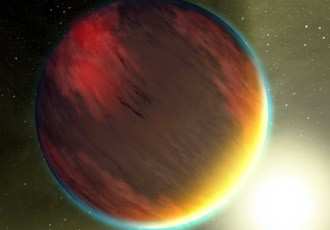Spitzer Continues To Amaze Researchers
For the first time ever, a NASA telescope has captured enough
light from planets outside Earth's solar system to identify
individual molecules present in their atmospheres. The space agency
says data obtained by the Spitzer Space Telescope is a significant
step toward being able to detect possible life on rocky exoplanets,
and comes years before astronomers had anticipated.

"This is an amazing surprise," said Spitzer project scientist
Dr. Michael Werner of NASA's Jet Propulsion Laboratory, Pasadena,
CA. "We had no idea when we designed Spitzer that it would make
such a dramatic step in characterizing exoplanets."
Spitzer, a space-based infrared telescope, obtained the detailed
data, called spectra, for two different gas exoplanets. Called HD
209458b and HD 189733b, these so-called "hot Jupiters" are, like
Jupiter, made of gas, but orbit much closer to their suns.
The data indicate the two planets are drier and cloudier than
predicted. Theorists thought hot Jupiters would have lots of water
in their atmospheres, but surprisingly none was found around HD
209458b and HD 189733b.
According to astronomers, water might still be present -- but
buried under a thick blanket of high, waterless clouds that may be
filled with dust.
 One of the planets, HD 209458b, showed hints of tiny sand
grains, called silicates, in its atmosphere. (Need a visual?
Think Phoenix, AZ during a summertime wind storm -- times 100...
Ed.) NASA theorizes this could mean the planet's skies are
filled with high, dusty clouds unlike anything seen around planets
in our own solar system.
One of the planets, HD 209458b, showed hints of tiny sand
grains, called silicates, in its atmosphere. (Need a visual?
Think Phoenix, AZ during a summertime wind storm -- times 100...
Ed.) NASA theorizes this could mean the planet's skies are
filled with high, dusty clouds unlike anything seen around planets
in our own solar system.
"The theorists' heads were spinning when they saw the data,"
said Dr. Jeremy Richardson of NASA's Goddard Space Flight Center in
Greenbelt, MD.
"It is virtually impossible for water, in the form of vapor, to
be absent from the planet, so it must be hidden, probably by the
dusty cloud layer we detected in our spectrum," he said.
A spectrum is created when an instrument called a spectrograph
splits light from an object into its different wavelengths, just as
a prism turns sunlight into a rainbow. The resulting pattern of
light, the spectrum, reveals "fingerprints" of chemicals making up
the object.
Until now, the only planets for which spectra were available
belonged in our own solar system. The planets in the Spitzer
studies orbit stars that are so far away, they are too faint to be
seen with the naked eye. HD 189733b is 370 trillion miles away in
the constellation Vulpecula, and HD 209458b is 904 trillion miles
away in the constellation Pegasus. That means both planets are at
least about a million times farther away from us than Jupiter.
In the future, astronomers hope to have spectra for smaller,
rocky planets beyond our solar system. This would allow them to
look for the footprints of life -- molecules key to the existence
of life, such as oxygen and possibly even chlorophyll.
"With these new observations, we are refining the tools that we
will one day need to find life elsewhere if it exists," said Dr.
Mark R. Swain of JPL. "It's sort of like a dress rehearsal."

Previous observations of HD 209458b by NASA's Hubble Space
Telescope revealed individual elements, such as sodium, oxygen,
carbon and hydrogen, that bounce around the very top of the planet,
a region higher up than that probed in the Spitzer studies and a
region where molecules like water would break apart.
 ANN's Daily Aero-Linx (04.16.24)
ANN's Daily Aero-Linx (04.16.24) Aero-News: Quote of the Day (04.16.24)
Aero-News: Quote of the Day (04.16.24) Airborne 04.10.24: SnF24!, A50 Heritage Reveal, HeliCycle!, Montaer MC-01
Airborne 04.10.24: SnF24!, A50 Heritage Reveal, HeliCycle!, Montaer MC-01 Airborne 04.12.24: SnF24!, G100UL Is Here, Holy Micro, Plane Tags
Airborne 04.12.24: SnF24!, G100UL Is Here, Holy Micro, Plane Tags Airborne-Flight Training 04.17.24: Feds Need Controllers, Spirit Delay, Redbird
Airborne-Flight Training 04.17.24: Feds Need Controllers, Spirit Delay, Redbird





